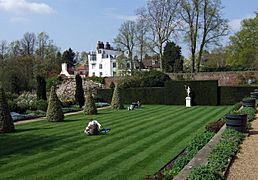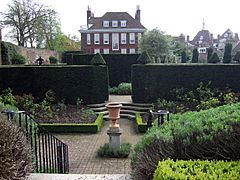Fenton House facts for kids
Quick facts for kids Fenton House |
|
|---|---|
 |
|
| Former names | Ostend House (early C18) Clock House (later C18) |
| General information | |
| Type | Merchant's house |
| Architectural style | Georgian architecture with many slightly earlier core features |
| Location | Hampstead (village) London, NW3 United Kingdom |
| Coordinates | 51°33′32.01″N 0°10′46.85″W / 51.5588917°N 0.1796806°W |
| Completed | 1693 |
| Owner | National Trust |
| Technical details | |
| Material | Brick |
| Floor count | 4 |
| Designations | Grade I listed |
Fenton House is a historic house in Hampstead, North London. It was built in the 17th century for a wealthy merchant. Today, it belongs to the National Trust, a charity that protects historic places. Lady Binning, the last person to live there, gave the house to the National Trust in 1952.
Fenton House is a detached house, meaning it stands alone. It has a large walled garden, which is quite big for London. The garden includes a special sunken garden, an orchard with fruit trees, and a kitchen garden where vegetables and herbs were grown.
Contents
What You Can See Inside
The house is filled with many interesting collections.
Musical Instruments
Fenton House has a special collection of old keyboard instruments. These are part of the Benton Fletcher collection. Sometimes, musicians play these instruments for visitors. This lets you hear what music sounded like hundreds of years ago!
Art and Antiques
You can also see many paintings inside Fenton House. These include the collection of Peter Barkworth. There are also paintings on loan by the artist Sir William Nicholson.
The house displays beautiful porcelain items. These include fancy dishes from Meissen, England, and China. You can also find 17th-century needlework pictures. These are like embroidered artworks. The house also has Georgian furniture, which means it's from the 18th and early 19th centuries.
Royal Portraits
Fenton House features interesting portraits of historical figures. You can see paintings of King William IV. He was once known as the Duke of Clarence. There are also portraits of his brother, King George IV. These paintings help us imagine what these important people looked like.
The Orchard and Garden
The brick house has the year 1693 carved on its chimney. This shows when most of the house was built. One of the most special parts of Fenton House is its 300-year-old orchard.
Apple Day
This orchard is home to about 30 different kinds of apple trees. Many of these are rare types of apples. Every year in late September, Fenton House holds an "Apple Day." Visitors can taste some of these unique and tasty apples. They can also try other treats, like honey made from apple blossoms. It's a fun way to learn about old apple varieties.
Changes Over Time
Fenton House has changed its look a few times over the centuries.
19th Century Remodel
In 1793, a merchant from Riga named PI Fenton bought the house. During the 19th century, he made many changes to the building. He updated the roof and added a fancy door frame called a portico. He also added a triangular shape above the door, known as a pediment. New window frames and glass were also installed.
The sides of the house have flat, decorative walls called parapets. These are above a decorative ledge known as a cornice. These parts were added after the 17th century.
Inside the House
Inside, the house still has its original staircases. These stairs have twisted balusters, which are the decorative posts that support the handrail. Many of the main rooms have their original wooden wall panels. They also feature corner cupboards and beautiful marble fireplaces with carvings.
Later Additions
Around 1936, a small extension was added to the west side of the house. This part only added a little bit to the building's size. It is thought that Lady Binning, the last owner, had this small section built.
Gallery





